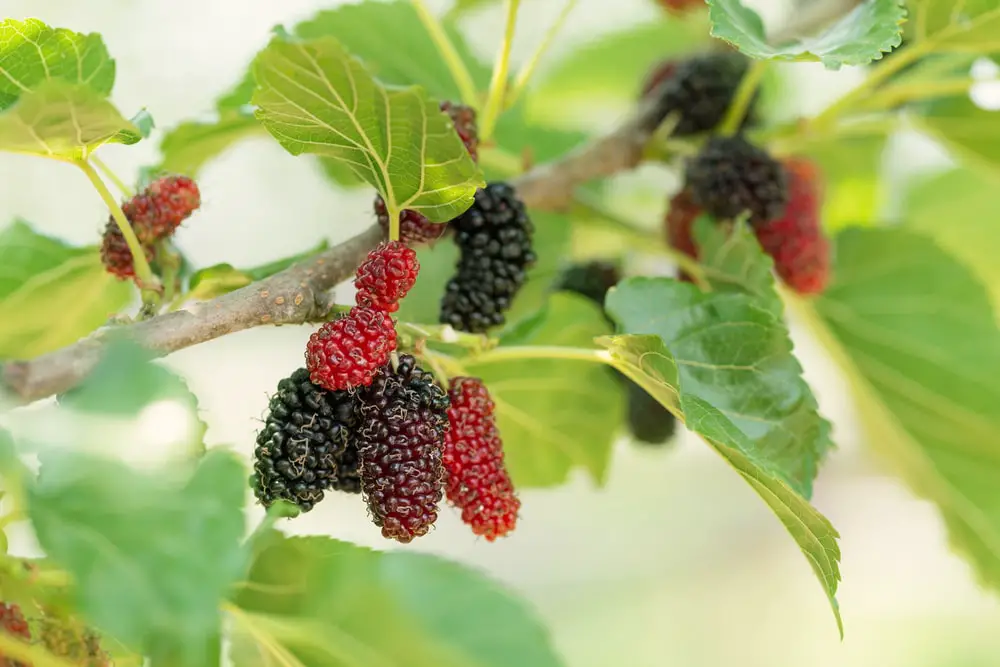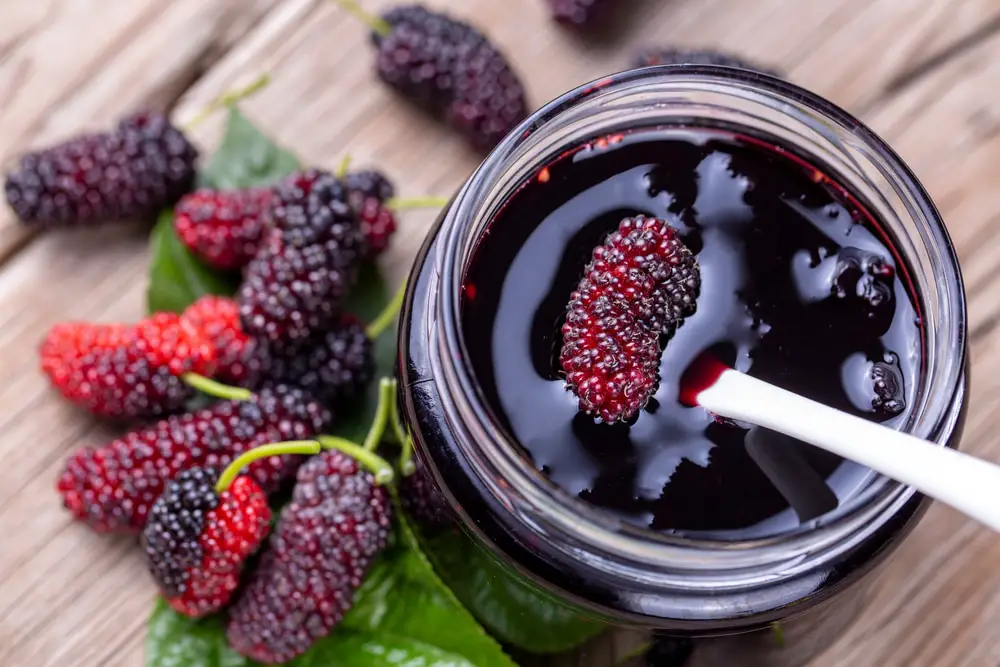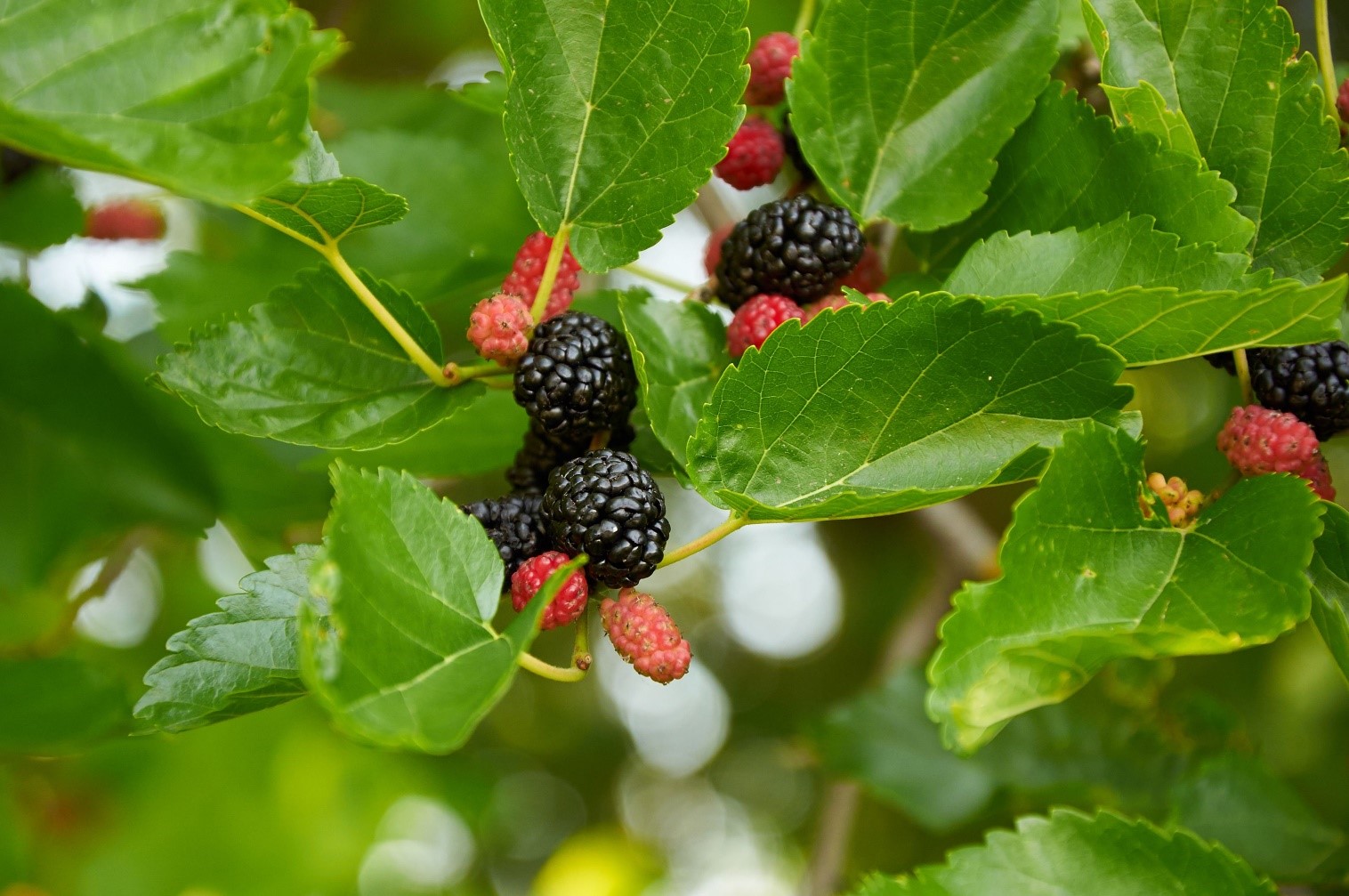Let’s get started on growing and caring for your mulberry tree!
Growing and Caring for a Mulberry Tree in 9 Easy Steps
Growing your own mulberry tree can be a rewarding and delicious experience. These trees are relatively easy to care for and can produce fruit for many years. In this article we show you 9 easy steps to grow and care for your mulberry tree.
1. Select the best site for your mulberry tree.
When deciding where to plant your mulberry tree, keep the tree’s sunshine and soil requirements in mind.
Mulberry trees require full sun or partial shade, as well as well-drained soil.
Full sun indicates that the tree will receive sunlight for at least 6 hours of direct sunlight per day whereas partial shade indicates that the tree will receive some direct sunlight and indirect or dappled light.
Mulberry trees require lots of sunlight to grow and provide fruit, so place them in an area that receives a minimum of 6 hours of direct sunlight per day.
Mulberry trees can survive a wide range of soil types, although they prefer a slightly acidic pH to be neutral.
The pH of the soil indicates its acidity or alkalinity, with a pH of 7 indicating neutrality, a pH less than 7 indicating acidity, and a pH more than 7 indicating alkalinity.
Mulberry trees can do well in slightly acidic or neutral soil but may have trouble in very alkaline soil.
To ensure your mulberry tree grows in the best way possible, check the pH of the soil before you plant it and make any changes needed to bring the pH into the suitable range.

2. Choose between planting a seed and a sapling.
You should consider many factors when determining whether to plant a mulberry tree from a seed or a sapling.
Planting a mulberry tree from seed can be a satisfying and less expensive option, but it will take longer for the tree to grow and produce fruit.
Mulberry tree seeds should be planted in a small container of seed compost and kept moist until germinating.
When the seedlings are big enough, they can be planted in the ground.
On the other hand, a mulberry tree planted from seed may take several years to bear fruit.
Planting a mulberry tree from a seedling, is a faster way to have a tree that is ready to produce fruit.
Saplings, or young trees, can be purchased from a nursery or an internet retailer.
Digging a hole twice as wide and just as deep as the root ball when transplanting a sapling is critical.
Place the sapling carefully in the hole, and ensure that the root ball is level with the soil surface.
Fill the hole with soil and push it down gently to remove any air pockets.
Depending on the kind of soil and growing conditions, a mulberry tree planted from a seedling may begin producing fruit within a few years.
Finally, whether you plant a seed or a sapling will be determined by your preferences and the amount of time and effort you are willing to devote to the tree.
3. Get the soil ready.
Preparing the soil before planting a mulberry tree is critical to guarantee that the tree grows in the best conditions possible.
You must loosen the soil and then mix into the compost or other organic materials to help it drain and grow plants.
To prepare the soil, use a garden fork or spade to loosen it to a depth of at least 12 inches.
This will aid in the establishment of the tree’s roots and encourage healthy growth.
Then, add a layer of compost or well-rotted organic matter to the soil.
Compost is a rich, natural fertilizer made from decomposed plant matter. It adds nutrients to the soil and improves its structure at the same time.
Mixing in compost or organic debris will help increase the soil’s drainage and fertility, benefiting the mulberry tree.
Test the pH of the soil after preparing it to check that it is within the desired range for mulberry trees.
Mulberry trees prefer a pH range of slightly acidic to neutral, with 6.5 to 7 being the best.
If the pH of the soil falls outside of this range, you can correct it with additives such as sulfur or lime.
Before you plant a mulberry tree, you can make sure it grows well by getting the soil ready.
4. Establish your mulberry tree.
There are a few procedures to follow when planting a mulberry tree to give the tree the best chance of survival and growth.
First, find a site for the tree that provides adequate sunlight and soil.
Mulberry trees do best in soil that drains well and has a pH between slightly acidic and neutral. They like full sun or partial shade.
Decide whether to plant a seed or a sapling next.
Plant seeds in a tiny pot filled with seed compost and keep them moist until they germinate.
When the seedlings are big enough, they can be planted in the ground.
Dig a hole twice as broad and just as deep as the root ball when planting a sapling.
Place the tree carefully in the hole, ensuring the root ball is level with the soil surface.
Fill the hole with soil and push it down gently to remove any air pockets. Deeply water the tree to help it establish itself.
Mulch around the tree’s base to help conserve moisture and keep weeds at bay.
Mulch can be formed from various materials, including wood chips, bark, straw, and grass clippings.
You may successfully plant a mulberry tree and give it the best chance of growing and thriving if you follow these guidelines.
5. Water your mulberry tree on a regular basis.
Watering your mulberry tree regularly is critical to its general health and growth.
Watering the tree extensively will foster deep root growth, which is vital for the tree’s stability and drought resistance.
To water your mulberry tree, apply water to the tree’s base with a garden hose or watering can.
To guarantee that the tree’s roots receive adequate moisture, moisten the soil to a depth of at least 12 inches.
Avoid getting water on the tree’s foliage, as this can promote the growth of fungal diseases.
Mulberry trees require around an inch of water each week on average, but this might vary based on weather, soil type, and other factors.
Check the soil moisture by putting your finger approximately an inch into the soil to determine when to water your tree. It is time to water the tree if the soil feels dry.
Wait a few days if the soil seems moist before watering again.
Watering your mulberry tree regularly will help it grow and produce fruit.
Interesting fact: The berries this tree bears are stunning, and they immediately remind you of England’s most popular blackberry, although the lobes of the fruit are a little more compact with a longer, thinner shape.
6. Feed your mulberry tree.
Fertilizing your mulberry tree might aid in its growth and fruit production.
Mulberry trees benefit from fertilizing regularly to maintain healthy growth and fruit output.
Numerous fertilizers are available, and it is critical to select one that is right for your tree.
Mulberry trees benefit from a balanced fertilizer, such as an NPK ratio of 10-10-10 or 20-20-20.
NPK stands for nitrogen, phosphorus, and potassium, the three primary nutrients plants require for proper growth.
Follow the label instructions for the fertilizer you use to fertilize your mulberry tree.
This usually entails applying the fertilizer to the soil around the tree’s base at the specified dosage and frequency.
Avoid getting fertilizer on the tree’s foliage, as this might cause the leaves to burn.
Fertilizing your mulberry tree can help it grow and produce fruit, but don’t over-fertilize it.
Excess fertilizer can cause excessive growth at the expense of fruit yield and nutrient imbalances that can harm the tree.
You may help your mulberry tree grow and produce fruit by fertilizing it according to the label directions.
7. Trim the mulberry tree.
Pruning your mulberry tree can help it grow healthy and produce fruit.
Mulberry trees require little trimming, but removing any dead, diseased, or damaged branches is critical to promote healthy development.
Use clean, sharp pruning shears or a pruning saw to prune your mulberry tree.
Cut cleanly at a 45-degree angle, directly above a leaf or branch junction.
Stubs should be avoided since they can promote disease growth.
Mulberry trees should be pruned in the late winter or early spring when they are dormant.
This will help you to view the tree’s structure more clearly and make more informed pruning decisions.
Pruning should be avoided during the growing season since it can stimulate new growth that may have needed more time to harden off before winter.
You may assist your mulberry tree in growing and produce fruit by trimming it on a regular basis and removing any dead, diseased, or damaged branches.
Over-pruning, on the other hand, can stress the tree and diminish fruit output.
8. Keep pests and illnesses away from your mulberry tree.
Mulberry trees are generally resistant to pests and diseases but can be damaged by various problems.
To preserve your mulberry tree’s overall health and growth, it is critical to protect it against pests and illnesses.
Mulberry fruit flies, aphids, and mites are some of the most frequent pests that can harm mulberry trees.
Mulberry fruit flies can harm the fruit and diminish the productivity of the tree, whereas aphids and mites can cause leaf damage and restricted growth.
You can use insecticides or natural alternatives, such as releasing beneficial insects or traps to protect your mulberry tree from pests.
Mulberry trees can also be impacted by diseases such as powdery mildew, which causes the leaves to turn white and powdery.
Removing any sick leaves and branches and avoiding overloading the tree is critical to prevent disease transmission.
You can also try using a fungicide as directed on the label to prevent the spread of fungal diseases.
You can help your mulberry tree flourish and produce fruit by safeguarding it from pests and illnesses. If you discover any concerns with your tree, you should talk with a specialist or conduct additional research to identify the best course of action.
9. Collect the mulberry fruit.
Mulberries are delicious and can be used in various cuisines, so harvesting the fruit of your mulberry tree may be a gratifying experience.
Mulberry trees typically begin bearing fruit after they have reached full maturity, which is usually around the age of ten years.
When the fruit is full and dark in color, it is ready to harvest. Pluck the fruit from the tree and eat it fresh, or use it to make pies, jams, or smoothies.
Mulberries can be kept in the refrigerator for a few days or frozen for more extended periods.
To harvest your mulberry fruit, grasp the stem with one hand and carefully twist and take it away from the tree.
Avoid injuring the tree’s limbs, as this can diminish the tree’s fruit yield.
You can enjoy your tree’s tasty and nutritious fruit by harvesting it. Just remember to leave some fruit for the birds and other creatures to enjoy!

Mulberry 101
- Mulberry tree, red mulberry, and white mulberry are all common names for this plant.
- Morus spp. is the botanical name for this plant.
- The plant is a deciduous tree.
- Mature Dimensions: 30-60 feet tall, 20-40 feet broad
- Full or partial sun exposure
- Rich, damp, yet well-drained soil
- pH of soil: mildly acidic to neutral
- Bloom Season: Spring
- Color of the flower: yellowish-green
- Zones of hardiness: 4-8 (USDA)
- North America and China are native ranges.
- Toxicity: Unripe fruit and leaves are somewhat poisonous to humans.
- Mulberry Tree Varieties
Mulberry trees come in various sizes and shapes, as well as the color and flavor of their fruit.
Mulberry trees are commonly found in the following varieties:
- White mulberry (Morus alba): A popular variety of mulberry trees native to China that is widely planted worldwide. It boasts sweet and juicy white, non-staining fruit.
- Red mulberry (Morus rubra): This mulberry tree is native to the eastern United States and produces sweet and flavorful dark red fruit.
- Black mulberry (Morus nigra): This mulberry tree is endemic to Western Asia and produces sweet and juicy dark purple or black fruit.
- Paper mulberry (Broussonetia papyrifera): This is an Asian tropical tree planted for its bark, which is used to produce paper. It produces little crimson fruit that is rarely eaten.
- Dwarf mulberry (Morus sp.): Various dwarf, mulberry tree kinds, are smaller in size and ideal for planting in pots or small gardens. They feature fruit ranging in hue from white to black with flavors ranging from sweet to sour.
These are just a few of the wide varieties of mulberry trees available. Each species has its own personality and can be a delightful addition to the garden.
Mulberries: Their History and Interesting Facts
- Mulberries are a species of fruit-bearing tree in the Moraceae family.
- The fig tree and other tiny trees and plants are also members of this family.
- On the other hand, the larger mulberry trees stand out for their tenacity and capacity to yield high-quality fruit.
- These trees are well-known for their ability to grow and bear fruit in cooler climes.
- Mulberry tree fruit is highly valued for its gorgeous appearance and incredible taste.
- It is frequently used in a wide range of foods and recipes and is enjoyed by people worldwide.
- Mulberry trees are regarded for their cosmetic advantages and culinary worth and are frequently grown for their appealing appearance and shade-providing capabilities.
- Mulberry trees are an excellent and flexible addition to any landscape or garden.
Did you know that Mulberry Trees Change Gender?
Mulberries are fast-growing and long-living deciduous trees that can reach heights of 30 to 50 feet.
Many of the trees are self-pollinating, with both male and female flowers on the same limb.
These trees have even been observed to shift gender.
Mulberry Applications
Mulberries are commonly used for a variety of purposes, including:
- Mulberries can be consumed fresh, either on their own or in various cuisines and sweets. They can also be dried or stored and used later.
- Mulberries can be used to make juice or wine, which can be consumed on their own or as an ingredient in cocktails or other drinks.
- Mulberries can be used in various baked items, including pies, tarts, and muffins. They are also helpful for making jams, jellies, and other spreads.
- Mulberries have been used medicinally for centuries to cure various diseases, including diabetes, high cholesterol, and constipation.
- They are also known to have anti-inflammatory qualities and may benefit skin and hair health.
- Mulberries are sometimes fed to livestock as a source of food, such as goats and sheep.
The Fruits Even the berries produced by this tree are striking, and it quickly seems to you that they resemble England’s most popular blackberry, with the exception that the fruit lobes are a bit more compact and have a longer, thinner shape.
Mulberries Have Delicious and Diverse Flavors
The flavors of these berries vary depending on where they are cultivated.
However, they all taste delicious to both children and their parents.
When out walking, I’ve heard that if a person observes a Mulberry Tree , they can’t walk past it without picking a handful of the Berries.
, they can’t walk past it without picking a handful of the Berries.
Unfortunately, the red ones leave dark spots on garments that are nearly impossible to remove!
Mulberry Trees’ Unforeseen Consequences: Pollen Overload Forces Bans in Three States
It’s noteworthy that the City of Tucson in Arizona prohibited these trees in 1984, and Las Vegas followed suit in 1991; a year later, in 1992, El Paso, Texas, followed suit.
Why?
All three cities said that the massive amount of pollen emitted by the trees was hazardous to humans.
How and why should a mulberry tree be removed?
You may desire to remove a mulberry tree for a variety of reasons, including:
- The tree has been infected or is dying and cannot be salvaged.
- The tree is excessively huge and produces issues (e.g., blocking sunlight and causing structural damage to a building).
- The tree is in an undesirable position (e.g., in the middle of a lawn where it is difficult to mow around).
If you elect to cut down the tree, you have several options:
- If the tree is small enough and you are comfortable using instruments such as a chainsaw, you can cut it down yourself.
- Engage the services of a professional tree removal agency to cut down the tree for you.
- This is advised for larger trees or if you are unfamiliar with chainsaws.
- If the tree is little, use a shovel and some elbow grease to pull it up by the roots.
Taking basic safety precautions, such as donning protective gear and staying clear of power lines, is critical when removing a tree.
Read More:
How to Properly Grow and Care for the Meyer Lemon Tree
7 Growth Stages of a Lemon Tree

